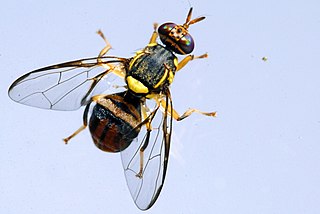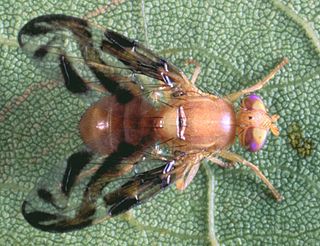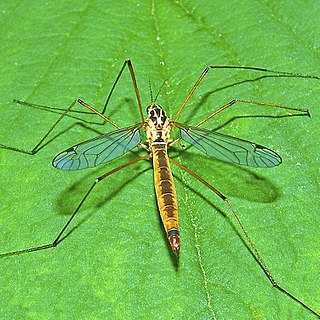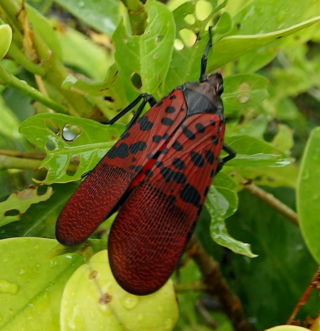
The beautiful demoiselle is a species of damselfly belonging to the family Calopterygidae. It is found in Europe, North Africa, and Western Asia. It is often found along fast-flowing waters.

The Tephritidae are one of two fly families referred to as fruit flies, the other family being the Drosophilidae. The family Tephritidae does not include the biological model organisms of the genus Drosophila, which is often called the "common fruit fly". Nearly 5,000 described species of tephritid fruit fly are categorized in almost 500 genera of the Tephritidae. Description, recategorization, and genetic analyses are constantly changing the taxonomy of this family. To distinguish them from the Drosophilidae, the Tephritidae are sometimes called peacock flies, in reference to their elaborate and colorful markings. The name comes from the Greek τεφρος, tephros, meaning "ash grey". They are found in all the biogeographic realms.

Volucella zonaria, the hornet mimic hoverfly, is a species of hoverfly. These flies are capable of buzz pollination.

Clusiosomina is a genus of tephritid fruit flies in the family Tephritidae. Occurring in eastern Australia, it is a monotypic taxon with the single species Clusiosomina puncticeps.

Euleia heraclei, known as the celery fly or the hogweed picture-wing fly is a species of tephritid or fruit flies in the genus Euleia of the family Tephritidae.
Rhagoletis juglandis, also known as the walnut husk fly, is a species of tephritid or fruit fly in the family Tephritidae. It is closely related to the walnut husk maggot Rhagoletis suavis. This species of fly belongs to the R. suavis group, which has a natural history consistent with allopatric speciation. The flies belonging to this group are morphologically distinguishable.

Rhagoletis meigenii, common name barberry fly or yellow berberis fruit fly, is a species of tephritid or fruit flies in the genus Rhagoletis of the family Tephritidae.

Conops quadrifasciatus, the yellow-banded conops, is a species of fly from the genus Conops in the family Conopidae.

Psila fimetaria is a species of fly, a member of the family Psilidae.

Bactrocera (Bactrocera) invadens is the name given to tephritid fruit flies that were introduced to East Africa from Sri Lanka and subsequently invaded practically the whole of Sub-Saharan Africa, hence the species name "invadens". It was first shown to be the same biological species as B. dorsalis s.s. by possessing identical sex pheromonal components after consumption of methyl eugenol, and also based on CO1 and rDNA sequences. Subsequently, it was agreed that B. invadens, B. papayae and B. philippinensis be synonymized as B. dorsalis. To counteract its detrimental effects to the fruit business, the industry resorts to cold treatment in order to get rid of the larvae.

Anastrepha suspensa, known as the Caribbean fruit fly, the Greater Antillean fruit fly, guava fruit fly, or the Caribfly, is a species of tephritid fruit fly. As the names suggest, these flies feed on and develop in a variety of fruits, primarily in the Caribbean. They mainly infest mature to overripe fruits. While thought to have originated in Cuba, the Caribbean fruit fly can now also be found in Florida, Hispaniola, and Puerto Rico.

Terellia serratulae is a species of tephritid or fruit flies in the family Tephritidae.

Orellia falcata is a species of tephritid or fruit flies in the family Tephritidae.

Nephrotoma cornicina is a species of fly in the family Tipulidae.

Terellia tussilaginis, the gall fly, is a species of tephritid or fruit flies in the family Tephritidae.

Terellia ceratocera is a species of tephritid or fruit flies in the family Tephritidae.

Choerades marginata is a species of robber fly found in Europe.

Bactrocera carambolae, also known as the carambola fruit fly, is a fruit fly species in the family Tephritidae, and is native to Asia. This species was discovered by Drew and Hancock in 1994.

Anastrepha fraterculus, known as the South American fruit fly, is a fruit fly species from the genus Anastrepha. A. fraterculus is a polyphagous, frugivorous fly that is a significant pest of commercial fruit production in South America.

Lycorma meliae is a planthopper species endemic to Taiwan, with multiple, dramatically different color morphs depending on the life stage. The species was described by Masayo Kato in Taiwan in 1929, and is the only member of its genus confirmed to be native to the island. In 1929, a specimen of L. meliae was originally described as a separate species, L. olivacea, also by Kato. These two taxon names were declared synonymous in 2023. L. meliae undergoes four instar stages before achieving adulthood and specimen generally only survive till the winter.



















